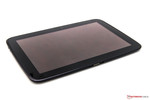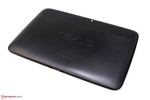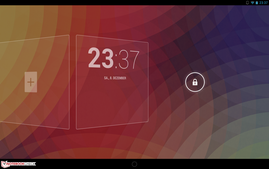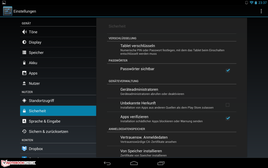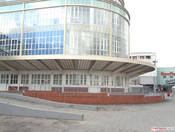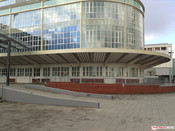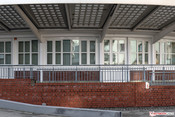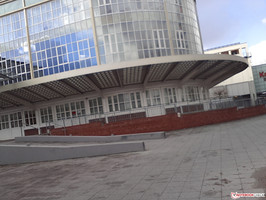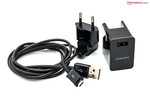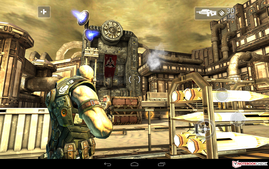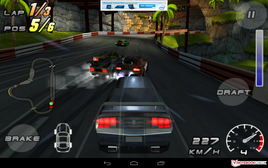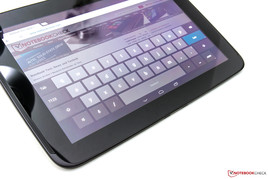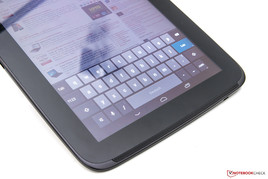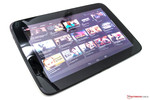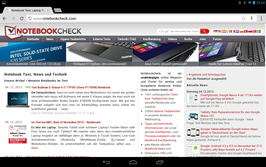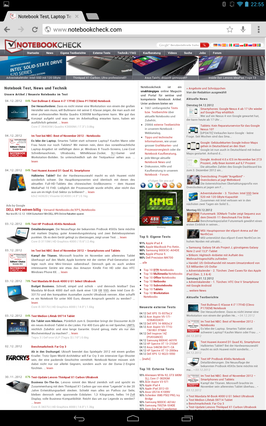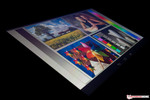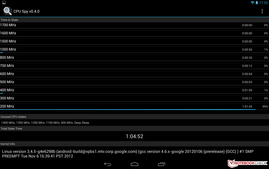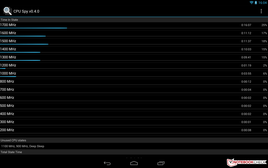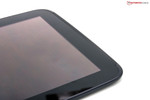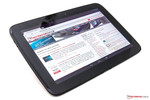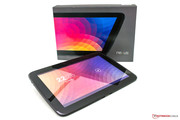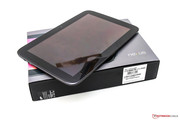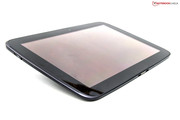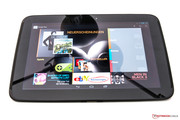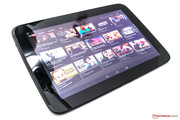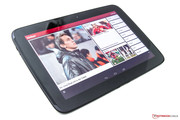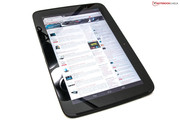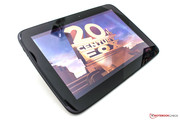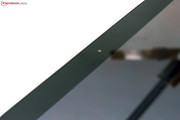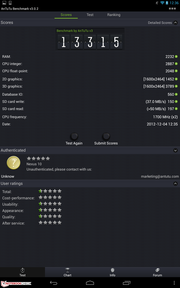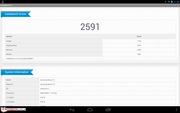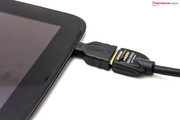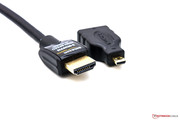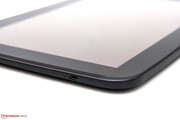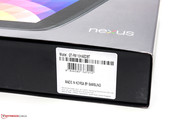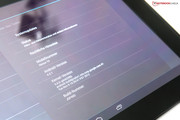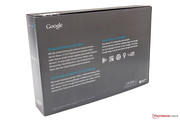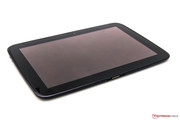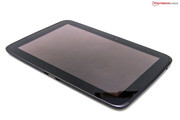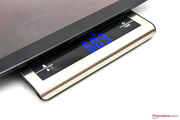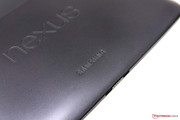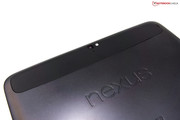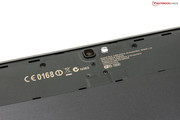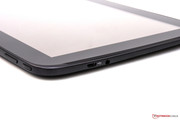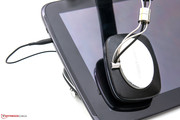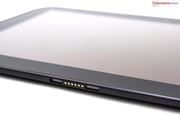Review Google Nexus 10 Tablet

For the original German review, see here.
Despite the canceled launch event, Google caused a big sensation by introducing its new Nexus lineup to the technology world on 29th October. Besides the better equipped Google Nexus 7 (made by Asus) that features 32 GB of memory and a 3G module for 300 Euros and the new Nexus 4 smartphone (made by LG) that sports a 4.7-inch screen and which is more or less available for a price starting at 300 Euros ($400), the company in conjunction with Samsung also introduced the new high-end Nexus 10. The 10.1-inch PLS screen features a resolution of 2560 x 1600 pixels and provides a pixel density of 300 dpi. A dual-core SoC from Samsung, 2 GB of working memory and either 16 or 32 GB memory capacity also belongs to the configuration.
But we will need to mention a couple of glaring misses: A model featuring a 3G or LTE is currently not available and a card reader for inexpensively expanding the memory capacity is not installed. But the tablet made by Samsung dubbed the GT-P8110 comes with the latest Android 4.2.1 operating system, aka Jelly Bean. Google and Samsung set standards with a start price of 399 Euros (or about $530 RRP). Apple's iPad 4 costs 100 Euros more in this configuration. We checked the Nexus 10's qualities and compared it with its two strongest competitors on the market.
Case
The casing of Google's Nexus 10 makes a good first impression. The chassis is based on polycarbonate and both the rear and the sides sport a pleasant rubber coating. Overall, the tablet looks very basic and modern due to the casing's black parts. It is inevitable that fingerprints are soon seen on the device's front and back. An accompanying microfiber cloth is almost a must for cleaning on the go.
The stability is very good. The tablet can only be twisted marginally with higher force. We did not notice any unusual noises that often characterize bad workmanship. In terms of feel, there is a natural difference between the Nexus 10's rubberized back and the aluminum unibody of Apple's iPad 4. In the editor's opinion, the feel of the test device is more appealing than that of Google's Nexus 7. It makes a very solid impression of stability on the user.
With dimensions of 264 x 178 x 8.9 millimeters (w x d x h) and total weight of 603 grams, Google's new tablet is within the usual range for this size. Apple's iPad 4 is thicker with a height of 9.4 millimeters and somewhat heavier with a total weight of 652 grams (8% difference). The specifications of Microsoft's Surface RT featuring a 10.6 inch screen only differ slightly.
Connectivity
Memory card readers are "just confusing for users" - at least according to a Google director. Such a declaration would have been expected from Apple. But does a card reader really have to be installed? The option of either 16 or 32 GB (net: 27.26 GB) internal memory should suit most users. On the other hand, a micro SD card is much cheaper and provides a certain degree of flexibility. Although a reader is not a must have, the Nexus 10 has to accept a deduction in the field of connectivity.
Besides the audio jack, a micro USB port for synchronizing and charging the tablet is found on the left. Samsung incorporates a micro HDMI port on the other side. The tablet can be connected to the user's TV via a conventional HDMI cord and the corresponding adapter (approx. 7 Euros/$10). Last but not least is some focus on the lower edge. The device can also be recharged by connecting it via a magnetic Pogo pin. A dock for the Nexus 10 is not yet offered in Google's Play Store.
Software
The biggest advantage of the nexus devices is the unmodified Google Android operating system (Vanilla Android) with immediate updates on release. In this case, Android 4.2.1 Jelly Bean is installed. Users with a device from other manufacturers have to wait for months for an update since specific UI modifications have to be intricately ported. The unchanged version's performance is also impressive. The system runs extremely smooth on Google's Nexus 10.
Compared with Android 4.1 (Jelly Bean), the latest version provides many improvements. Among others, widgets on the lock screen, a revised camera app featuring a 360 degree panorama and increased security (malware scanner from third-party apps outside Google's Play Store).
Communication & GPS
There are various options for communication. The integrated Wi-Fi module will likely be the most used. It supports the transmission standard 802.11 b/g/n. Moreover, data can also be transmitted via Bluetooth 4.0 or NFC (near field communication). Files and contacts can be shared with other Android devices via Android Beam. Paying on the go via NFC is still in its infancy in Germany and is not available everywhere. Currently, there is no Nexus 10 featuring a UMTS (3G) or LTE module available.
We checked the tracking function via the application "GPS Test". Tracking the primary location only took 12 seconds. The overall accuracy fluctuated between two and twelve meters, which are acceptable rates. As long as the navigation application does not require a mobile data network, Google's tablet can also be used as a big navigation system in the car.
Cameras & Multimedia
The Nexus 10 features a primary camera of 5 megapixels (2560 x 1920 pixels) for snapshots. The quality is acceptable, but you should not expect too much. Compared with Apple's iPad Mini, the Android pictures are especially appealing when using the digital zoom. There is less noise in a direct comparison, although the quality decreases visibly. Of course, tablets cannot compete with the high-quality cameras from Sony and other established manufacturers. Video recordings in the 1080p standard at 30 frames per second (fps) is possible for this device, and is fast becoming a standard feature for a device in this segment. The front-facing camera of Google's Nexus 10 features 1.9 megapixels (720p) sensor and is sufficient for video chat.
In terms of multimedia, the test device supports all standard image, audio and video formats. Content can be purchased directly from Google's Play Store or transferred from the user's computer. Fans of high-resolution 1080p videos will soon find the 32 GB memory capacity to be severely limiting since one file can have a size of several gigabytes. 16 GB is enough for smaller 720p files or movie streaming from the Play Store. The basic media player programs are preinstalled. Other applications are available in the Store and most can be downloaded free of charge.
Accessories
Only the most necessary accessories are found in the box. These are a modular USB PSU, a USB cord and plugs for European sockets. Google does not yet sell accessories for the Nexus 10. However, there are hundreds of third-party products on the Internet and can often be used universally.
Warranty
Samsung includes a 24 month warranty period on materials and processing flaws. Only 6 months are given on expendables and the included accessories such as the built-in battery or charger. The repair service requests in Germany are processed by the partner company Datrepair situated in Flensburg.
Games
The integrated ARM Mali-T604 graphics unit ensures a good gaming performance. It is an OpenGL 3.0 and DirectX 11 capable component for ARM SoCs (system-on-a-chip) with up to four cores. Google's Nexus 10 did not exhibit any problems with sophisticated 3D games like ShadowGun or Need for Speed in the gaming tests. Overall, the device has pretty powerful hardware which will satisfy most, if not all tablet gamers.
Input Devices & Controls
Entering text is performed using the virtual keyboard that is faded in depending on the application or presetting. The QWERTZ layout is very generously sized in the landscape mode. The ideal blend of convenient handling and visible content above is available in the portrait mode. The big shift keys on the left and right stand out. A new feature of Android 4.2 is text inputting using a method very similar to the very popular “swipe” method employed by many devices using third-party tools. This feature is ultimately a matter of taste.
The controls via the capacitive multi-touchscreen are very satisfactory. Several fingers and gestures are detected without problems and taps are implemented immediately. Other navigation is performed via three virtual Android icons that are permanently visible at the lower edge. A bit of the available user interface is consequently sacrificed. Apple has implemented a physical "Home" button for years and waives on digital navigation components.
Display
Google enters the high-res tablet category with the Nexus 10. The glare-type, 10.1-inch touchscreen has a resolution of 2560 x 1600 pixels (WQXGA), and is protected by a layer of Corning's Gorilla Glass 2 and surpasses the "Retina" screen of Apple's iPad 4 (2048 x 1536 pixels, 264 dpi). The Surface RT's 1366 x 768 pixels is almost obsolete in comparison. 4 megapixels and a pixel density of around 300 dpi were calculated based on the Nexus' resolution and screen size. The single pixels are not visible. The 16:10 format is noticed positively when rendering movies. The black bars are very narrow in contrast to the iPad 4's 4:3 screen's where the bars are much wider.
We start our measurements with the brightness which we ascertained using Gossen's Mavo Monitor tool. The screen achieved an average brightness of 389.2 cd/m². The highest reading was 419 cd/m² which adds up to a maximum brightness difference of 54 cd/m². This deviation is not seen in practical use. The illumination rate of 87 percent is not exceptional and puts the tablet in the middle of the pack. Apple's iPad 4 and Microsoft's Surface RT are handily beaten in this segment.
| |||||||||||||||||||||||||
Brightness Distribution: 87 %
Center on Battery: 419 cd/m²
Contrast: 722:1 (Black: 0.58 cd/m²)
Black is reproduced without any visible gray cast due to the low black value of 0.58 cd/m². This also results in a high contrast ratio of 722:1. The aforementioned Nexus 10 competitors make a better impression with these rates. Black looks more saturated and the contrast is superior. Apart from the hard facts, the color reproduction and the focus are compelling.
The glossy Gorilla Glass is unforgiving in outdoor use. Reflections can never be completely prevented. However, the given brightness is more than sufficient in a shady place or on the couch in the living room. The content is always legible. It could get difficult in a light flooded room or direct sunlight in some situations. Then the seating position has to be changed when necessary.
The PLS (plane-to-line switching) technology developed by Samsung has several advantages. This derivative of the IPS (in-plane switching) technology consumes less power and is viewing angle independent. The reference picture does not show color deviations, inverting or fading even at very acute angles.
Performance
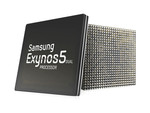
The heart of Google's Nexus 10 is Samsung's Exynos 5 Dual 5250 SoC with a clock rate of 1.7 GHz. This chip is a dual-core component based on the ARM Cortex A15 and is built using the 32 nanometer process. An ARM Mali-T604 graphics unit from the "Midgard" architecture, which features up to four cores is also included in this bundle. In addition to the main component, the tablet contains 2 GB of working memory and up to 32 GB of storage memory capacity.
Using the free application "CPU Spy", we checked the SoC's clock rate. The chip is 95% in deep sleep and only clocks with 200 MHz in idle. During load (Stability Test), the clock rates hover around 2/3rds and occasionally maxes out at 1.7 GHz.
The system test GeekBench 2 is the first hurdle in our benchmark course. This tool is available for various operating systems. The Nexus 10 beats Apple's iPad 4 in this benchmark. The iPad only wins the stream test with a marginal lead of five percent. Although Huawei's MediaPad 10 FHD has a similar price, it scores up to 50 percent worse than our sample in most tests.
The Nexus 10's higher performance is seen in the comparison with Huawei's tablet. There is a clear advantage of 39 percent in AnTuTu Benchmark v2. This looks different in Smartbench 2012. The Nexus 10 only has a lead of five percent. Apple's iPad 4 participates again in Linpack's multi-thread calculation. The device from Cupertino is miles ahead of the competition with 654 MFLOPS. Its advantage over Google's Nexus 10 is an awesome 244 percent.
| AnTuTu v2 - Total Score (sort by value) | |
| Google Nexus 10 | |
| Huawei MediaPad 10 FHD | |
| Smartbench 2012 - Productivity Index (sort by value) | |
| Google Nexus 10 | |
| Huawei MediaPad 10 FHD | |
| Linpack Android / IOS - Multi Thread (sort by value) | |
| Google Nexus 10 | |
| Apple iPad 4 | |
| Huawei MediaPad 10 FHD | |
The ARM Mali-T604 graphics unit was put through AnTuTu's 3DRating benchmark. The Nexus 10 is beaten by Apple's iPad 4 in the normal calculation using the device specific screen resolution. The average refresh rate is 13.5 fps with a score of 3764 points. In the off-screen benchmark with a fixed resolution of 1024 x 2048 pixels, the Nexus 10 takes a 51 percent lead (2881 points @ 9.9 fps).
The Nexus 10 has to admit clear defeat in the tried and tested GLBenchmark 2.5. The difference to the PowerVR SGX554MP4 graphics in Apple's tablet is 19 percent (36 vs. 43 fps) in the off-screen measurements. Huawei's MediaPad 10 FHD featuring a Vivante GC4000 GPU cannot keep up in the 3D tests.
| AnTuTu 3DRating | |
| 1024x2048 Off-screen (sort by value) | |
| Google Nexus 10 | |
| Apple iPad 4 | |
| --- (sort by value) | |
| Google Nexus 10 | |
| Apple iPad 4 | |
| GLBenchmark 2.5 | |
| 1920x1080 Egypt HD Offscreen Fixed Time (sort by value) | |
| Google Nexus 10 | |
| Apple iPad 4 | |
| Huawei MediaPad 10 FHD | |
| Egypt HD Fixed Time (sort by value) | |
| Google Nexus 10 | |
| Apple iPad 4 | |
| Huawei MediaPad 10 FHD | |
Microsoft's Surface RT steps into the ring in this browser benchmark. The Nexus 10 clearly wins the latest revision of Google's V8 benchmark with 2964 points. However, we have to point out that the benchmark, operating system and browser come from the same company. Microsoft's tablet, using Internet Explorer 10, scored much lower 796 points (73 percent difference).
The smallest possible result is significant in the independent Java script benchmark Sunspider version 0.9.1. Apple's iPad 4 wins the test with a result of 895.3 milliseconds and beats Microsoft's Surface RT (997.5 milliseconds) as well as Google's Nexus 10. The test device lags 33 and 26 percent behind the two stronger rivals respectively.
| Sunspider - 0.9.1 Total Score (sort by value) | |
| Google Nexus 10 | |
| Apple iPad 4 | |
| Microsoft Surface RT | |
| Huawei MediaPad 10 FHD | |
| Google V8 Ver. 7 - Google V8 Ver. 7 Score (sort by value) | |
| Google Nexus 10 | |
| Apple iPad 4 | |
| Microsoft Surface RT | |
| Huawei MediaPad 10 FHD | |
| Browsermark - --- (sort by value) | |
| Google Nexus 10 | |
| Apple iPad 4 | |
| Huawei MediaPad 10 FHD | |
* ... smaller is better
The internal flash memory also plays a part in the overall system performance. The storage device achieves good transfer rates of 99.53 MB/s (read) and 20.02 MB/s (write) in AndroBench 3. The Nexus 10 also convinces in the random tests.
Compared with the smaller Nexus devices from the current range, the big tablet takes a gigantic lead. A difference of 50 percent and more are recorded in sequential read operations. The Nexus 4 smartphone is only at an advantage in the Random Read 4KB (+17 percent). Altogether, it is a compelling performance that the internal memory gives.
| AndroBench 3-5 | |
| Random Write 4KB (sort by value) | |
| Google Nexus 10 | |
| Huawei MediaPad 10 FHD | |
| Google Nexus 4 | |
| Google Nexus 7 | |
| Random Read 4KB (sort by value) | |
| Google Nexus 10 | |
| Huawei MediaPad 10 FHD | |
| Google Nexus 4 | |
| Google Nexus 7 | |
| Sequential Write 256KB (sort by value) | |
| Google Nexus 10 | |
| Huawei MediaPad 10 FHD | |
| Google Nexus 4 | |
| Google Nexus 7 | |
| Sequential Read 256KB (sort by value) | |
| Google Nexus 10 | |
| Huawei MediaPad 10 FHD | |
| Google Nexus 4 | |
| Google Nexus 7 | |
Emissions
Temperature
The waste heat that the hardware produces is discharged passively via the case. The tablet gets lukewarm at most during light use (Office). This corresponds to the rates highlighted in blue in our table. The temperatures increase during load (app: Stability Test), but are acceptable. The rear gets noticeably warmer in the center. The fingers however do not touch this area in the landscape mode, but cannot be avoided in portrait mode. The rates are impressive for a device in this category.
(+) The maximum temperature on the upper side is 38 °C / 100 F, compared to the average of 33.7 °C / 93 F, ranging from 20.7 to 53.2 °C for the class Tablet.
(±) The bottom heats up to a maximum of 41.3 °C / 106 F, compared to the average of 33.2 °C / 92 F
(+) In idle usage, the average temperature for the upper side is 25.4 °C / 78 F, compared to the device average of 30 °C / 86 F.
Speakers
A tablet is a multimedia device. Google and Samsung have the right idea with the speaker. The speakers are located on the screen's left and right in landscape mode and provide real stereo sound. The speakers in Apple's iPad Mini are good, but their positioning at the bottom edge does not make sense. The sound from the Nexus speakers is good. Trebles are rendered clearly and the speakers do not produce distorted sound at maximum volume. Bass and low ranges are reproduced faintly. Peripherals can be connected via the 3.5 mm stereo jack or micro HDMI port.
Energy Management
Power Consumption
The component's energy consumption rates create the basis for a good battery life. The biggest power consumer is the 10.1 inch screen, and the power draw is particularly high at maximum brightness. Google's Nexus 10 consumes between 3.7 and 9 watts in idle. Samsung's SoC only clocks at 200 MHz in idle (deep sleep). A comparison with Apple's iPad 4 and Microsoft's Surface RT shows that these devices consume less power under Office use. The difference between the iPad and Nexus is 30 percent at the lower end (2.6 vs. 3.7 watts).
The consumption rates during load hardly change with 9.4 watts at most. Google's Nexus 10 can outperform the others in this scenario. Microsoft's Surface RT consumes 10.6 watts at the peak (13 percent difference). Apple's iPad 4 consumes roughly 33 percent more power with a maximum of 12.5 watts.
Another factor for a good battery runtime is the incorporated battery. Samsung relies on a lithium polymer battery with a capacity of 22.75 watt hours in this tablet. Apple installs a much bigger, 42 watt hour battery in similar dimensions
| Off / Standby | |
| Idle | |
| Load |
|
Key:
min: | |
Battery Life
We start the measuring the battery life in different scenarios with the maximum runtime. This is simulated by reading a text at minimum brightness. However, the Wi-Fi module is enabled in this device category since it is a web-based script. The tablet lasted for approximately 17 hours. Apple's iPad 4 with a larger battery managed over 21 hours. The 15 hours of the comparable Microsoft Surface RT is easily surpassed. The other extreme is the load test (Stability Test) using maximum brightness and enabled mobile technologies. A full charge was drained after 3 hours and 32 minutes.
The Wi-Fi surf test at a standardized brightness of 150 cd/m² is realistic. A different website is opened every 40 seconds. The runtime of nearly 11 hours makes a good impression. It was still 6 hours and 27 minutes in maximum brightness. Using the same settings for movie playback, the battery lasted 3 hours and 58 minutes (H264 - 1080p using the VLC Player Beta from Google's Play Store).
Verdict
Google and Samsung have launched a strong product in the market that is available for just 400 Euros ($530) dubbed the Nexus 10. At least, when it is not sold out. The slim casing featuring a rubber coating is very satisfactory and the unadulterated Android OS version 4.2 and a two year warranty make a positive impression. The connectivity is limited due to the lack of a card reader. Also a version with 3G or LTE module for mobile Internet access in our opinion is much needed to be competitive.
The driving force of Google's Nexus 10 is certainly the high-resolution PLS screen featuring a resolution of 2560 x 1600 pixels. The touchscreen makes a good impression in both the test and the general user experience. The use of Corning's Gorilla Glass 2 layer is a bane during outdoor use. The tablet's performance is compelling although Apple's iPad 4 was faster in many benchmarks. Android, iOS or Windows 8? This choice is a matter of personal preference.
In addition to the good battery runtimes, it was the stereo speakers' positioning and the screen that convinced us that this would be a good companion device. The produced sound could nevertheless be more balanced. All in all, a well-designed tablet that will quickly receive the newest software updates from Google is great. Google's Nexus 10 is a great alternative to Apple's iPad 4 and Microsoft's Surface RT in terms of price. We give the Nexus 10 a big thumbs-up.




